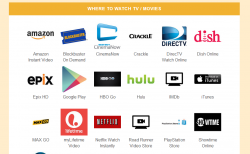Weekly News Roundup (19 May 2013)
Welcome to another edition of the WNR. I think I’m getting a little bit too excited about the new season of Arrested Development, coming exclusively to Netflix this time next week. I’ve got my unauthorised Netflix subscription up and running ready for the final countdown, preparing myself with a pre-launch binge watching of the previous season that I hope won’t turn out to be a huge mistake, and when May 26 rolls around, I’ll be ready to say “annyong” to all 15 glorious episodes of the new season.
Before I can do that, I’ll have to get through this week’s WNR.
 So it’s “Hollyweb” here we come. The W3C this week formally approved the use of the Encrypted Media Extensions (EME) to the HTML5 standard, which opens the door for DRM to be officially infected into HTML5 videos. EME won’t actually handle the DRM itself, but it’s a standardized framework that allows third-party DRM support.
So it’s “Hollyweb” here we come. The W3C this week formally approved the use of the Encrypted Media Extensions (EME) to the HTML5 standard, which opens the door for DRM to be officially infected into HTML5 videos. EME won’t actually handle the DRM itself, but it’s a standardized framework that allows third-party DRM support.
The W3C says this is actually good for the open web because since DRM isn’t going away, the alternative would be an increasingly closed off web reliant upon proprietary systems to DRM’d video delivery (so basically what’s happening now). Even without EMEs, someone will find someway to squeeze DRM into HTML5, but the framework won’t be standardized or open or managed by the W3C. Or worse, DRM’d videos like Netflix would simply move off the open web, and be confined to the “walled gardens” of apps.
Opponents of the move would point out that Flash and Silverlight, the two main proprietary systems used for DRM’d video delivery right now, are dying a slow death and a DRM-free HTML5 video standard would have forced a rethink on the whole DRM thing, for better or worse. But perhaps the W3C does have a point, in that the current climate would never allow DRM-free copyrighted videos to be distributed by Netflix, Hulu and others. If Flash and Silverlight officially dies or no longer works, and if DRM isn’t a viable option in HTML5, then just like the W3C predicts, we will lose the ability to use Netflix and Hulu and others via the web.
As expected, a lot of anger is being directed at the W3C, and the proponents of EME, Netflix, Google, Microsoft among others. But it’s important to remember that given a choice, none of these groups actually want DRM. Only Big Content is obsessed with DRM, and as long as they’re in the powerful position of being gatekeepers for the content we want, we will always have DRM. Let’s not forget who the enemy is.
And the enemy this week has been busy promoting its vision for Hollyweb, and how if you ignore the problems of DRM, unskippable ads, the arbitrary and fleeting nature of what is and isn’t available, and the sometimes high cost of it all, then there’s no way anyone should ever want to pirate. The MPAA this week launched a new website WheretoWatch.org to promote all the legal alternatives to piracy, providing a summary for most of the online based video services available today. It’s a slight change in tactics for the MPAA in their CRusade Against Piracy (CRAP™), designed to counter the argument that legal alternatives aren’t present.
Except that’s not the argument at all. The argument is that the legal alternatives, while definitely present, aren’t nearly good enough.
The problems? Content, for one. Netflix is probably the best, and certainly the most popular of the legal alternatives, but can you really honestly say that it has all the content that a typical web pirate would be looking for? I would actually say it’s the opposite, in that what Netflix has is all the stuff that pirates aren’t looking for. This isn’t a bad thing though, because due to the way BitTorrent transfers work, the “nobody wants to download” stuff are usually the ones that are quite hard to pirate as there just aren’t enough seeders normally. And sure, Hulu Plus has a lot of recent content, but that brings us to the second issue: ads.

Plenty of options, but none that will satisfy people like piracy will, even if you don’t consider the pricing discrepancy
Now, advertising is needed, that’s not a question. But when you have to sit through four 30-second unskippable commercial breaks for every 20 odd minutes of content, and when the ads are pretty much just the same set, then it gets boring rather quickly. And this is despite having paid a monthly subscription fee for content you could have recorded on TiVo for free.
And that’s only when the service you want allows you to pay for it in a standalone manner. Try and get HBO Go without a cable HBO subscription, and see how far you get.
For the content that you really want, cost then becomes the biggest obstacle. For example, the HD version of Life of Pi on the Australian iTunes costs $29.99, but you could have purchased the limited edition Blu-ray 3D/Blu-ray/DVD/Digital Copy edition last week for less than $27. Where is the sense in this, and is it Apple’s fault, or the fault of 20th Century Fox, the distributor of the film? The regional price gouging is not new, and even government sponsored investigations into this issue seems to have had no effect on this greedy practice.
But the biggest problem with WheretoWatch.org is the fact that it is almost completely useless for someone, like me, who isn’t in the United States. Almost all of the services listed are US only, and only a couple out of the rest are actually available in Australia (and usually with reduced content). The fact that the MPAA went to all this trouble and still managed to forget anyone who isn’t in the US is precisely the reason why piracy rates outside of the US are much much higher. The MPAA being a US based organisation can be used to excuse the US-centric nature of WheretoWatch.org, but this misses the point that the MPAA are also representatives of the owners and gatekeepers of the content that those of us outside of the US want to watch. I’m sure we would all pirate less in Australia is we had HBO, or Hulu, or Netflix, without having to go down the geo-unblocking route.
The problem with legal access will be a key point in a new proposed reform of France’s copyright laws. With HADOPI three-strikes proving to be entirely ineffective in stopping piracy and hugely unpopular, a new report titled Culture-Acte 2 aims to re-balance copyright law to address the shortcomings of HADOPI. While “three-strikes” will be kept under the recommendations, the report also calls for making films and TV shows to be available on on-demand services far quicker than the current 36-month average. There’s also suggestion of a smartphone/tablet tax of 1%, to help fund the reforms.
In my mind, the current piracy problems are almost entirely due a supply and demand issue. Demand is high, but supply is limited and restricted, all of it intentionally in order to squeeze more out of a particular market. This would normally work to keep prices and revenue high, but once piracy becomes an alternative supplier, one that’s super cheap as well, then the artificial supply limitations and restrictions only end up driving more “customers” to piracy. And due to DRM, lack of interoperability and other issues, the legal product is often inferior to the illegal version, compounding the issue further. There’s also a deep lack of understanding into the preferred method of consumption, with the “all-you-can-eat” nature of the web naturally encouraging consumers to want the same with their video consumption needs, but with the option usually unavailable for the content that people actually want, the new release content.
I’m not sure if the government can or should legislate how the demand should be met by supply, but punishing consumers for wanting something better doesn’t seem like the solution to me.
——
A new study has found that the game industry’s own reported piracy figures may be magnitudes higher than the real piracy rate. Shocking! What a total surprise!! [INSERT SARCASM SMILEY].
The new study by professors at the Aalborg University and the Copenhagen Business School found that while piracy rates were still quite high, 12.6 unique downloaders in a 3 month period, it wasn’t nearly as high as the 10 million downloads per month that the industry has been touting.
The discrepancy is easy to understand though. The industry figures are often released by groups, like the ESA, whose main mission is to publicize the severity of the piracy problem. This kind of self-interest promotes biased conclusions, intentionally or otherwise. This new study aims present the most objective figures so far independent of any industry interests.
It was also interesting to note that the top piracy countries were the likes of Romania, Croatia, Greece, Portugal and Hungary – looking at the availability and price of legal alternatives in these countries may yield further clues as to why so many people choose to pirate games in these countries. Hey, maybe all these countries need is their own version of WheretoPlay.org [ANOTHER SARCASM SMILEY]
![]()
The April NDP report is out, reporting on US video game sales for the month. As has been the trend recently, the report doesn’t make good reading.
The Xbox 360 was the most popular console yet again, but having only sold 130,000 units (45% down compared to a year ago), it was hard for Microsoft to celebrate this fact. Even with only 130,000 units sold, it still represented 42% of current generation home based console sales, meaning the Wii, Wii U and the PS3 added up to maybe less than 180,000 units. No matter how you split this (I’d say 35,000, 45,000 and 100,000 respectively), it doesn’t look good for any involved.
The Wii, PS3 and Xbox 360 figures are forgivable, but the Wii U’s slow decline into obscurity is disheartening. EA, the biggest game publisher in the world, said this week that they did not have a single Wii U game in development, and one EA engineers even called the console “crap” and said that it was less powerful than the Xbox 360. It’s definitely not looking good for Nintendo at the moment.
Anyway, we’ll find out more about the Xbox 720/Durango/Infinity this week. Being the last of the “next-gen” consoles to launch, all eyes are on Microsoft to see if they can up the ante on what’s on offer from Nintendo (shouldn’t be too hard) and Sony (much harder).
On that note, we come to the end of this WNR. Hope you’ve enjoyed reading it. See you next week.


